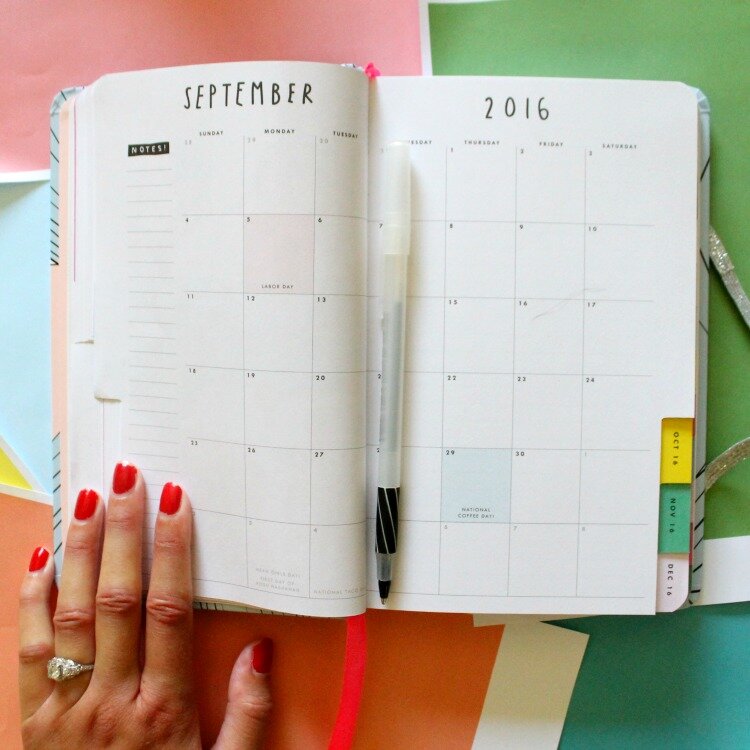I’ve been thinking a lot about the concept of planning out blog posts lately. When I first started blogging years ago, I liked the idea of sitting down and just writing something that was on my mind at the moment and hitting publish. This felt like the only “authentic” way to do it. Like if I took the time to plan things it would be kind of fake or staged or whatever.
I let go of that way of thinking pretty quickly as I got more serious about blogging. But every now and then it starts to sort of seep back into my brain. And that’s when I fall off track.
But I want you to understand just how huge of a difference planning makes for me when it comes to blogging. When I take the time to plan things and develop a process, it’s not just easier for me and my schedule, it also makes my posts so much better.
How to plan your blog posts
Keep a running list
There are definitely some ways you can seek out inspiration for blog post ideas. And we’ll get to those in a minute. But sometimes you just get inspired out of nowhere, so you need to be prepared for those times and not just rely on that sort of scheduled brainstorming.
What I do is set aside a small section of my planner (yeah, a regular old paper planner) where I can jot down ideas any time I get them. If I’m out when inspiration strikes, then I’ll make a note in my phone and copy it into my planner as soon as I get home.
You don’t have to do it this way. You can use Google Docs or Evernote or a big chalkboard in your office or whatever format you like! But the idea is for you to have a designated space for you to write down basic ideas that are totally out of the blue and maybe not totally flushed out just yet.
You can do all of that work later, but the important thing is that you just write down enough so that you’ll remember the idea later when you go to actually brainstorm and write. And having a designated place for those random ideas means that you’ll be more likely to actually write them down and then remember where to find them when you need them.
Go out of your way for inspiration
Okay, so now let’s talk about those times where you’re not feeling particularly inspired and you don’t have a bunch of extra ideas already written down. This happens to everyone and is totally not a reason to panic or to just stop posting on your blog or planning new posts. Instead, it’s a perfect time for you to seek out inspiration for new post ideas. And ideally, this can sort of help you get out of a creative funk.
So here’s the annoying part where I tell you that there’s no magic formula for doing this. You have to know yourself well enough to know what’s going to get those wheels turning in your brain enough for you to come up with some new ideas for posts. I like to browse Pinterest and Instagram and some of my favorite blogs to see if there are things that bring up new ideas for me. (Important: don’t just browse sites for post ideas in your niche and then use those ideas as your own – no one benefits from straight copying, but if something just gets you started on a new idea that’s great!)
That exact strategy might not work for you. You might be more likely to get inspired by reading magazines or taking walks or talking to collaborators. Or it might just be as simple as writing out a list of problems that your target audience could use some help with. Whatever it is, you need to determine what works best for you specifically, and then use that method (or methods) whenever you need some extra help coming up with ideas.
Think about a monthly theme
This is totally optional, but it’s something I’ve been thinking about doing recently. If you’re having a hard time coming up with ideas, or maybe if all your ideas seem really similar, you can have a rotating monthly theme to help you really nail down your content topics.
This doesn’t mean you should go totally off the deep end and switch from blogging about fashion to motorcycle maintenance to whatever else on a monthly basis. But there might be a certain topic within your niche that has your attention one month, and then another topic the next. And those can make for cool monthly blogging themes.
Again, you don’t have to do this. But it’s a neat idea. You can take whatever it is that’s inspiring you at the time and build your content around that one thing. And then switch it up each month while staying within your niche to keep the content fresh. It can also just make it easier to come up with post topics if you have a starting point like that. Since just trying to come up with anything and everything to blog about can get super overwhelming.
Create a monthly schedule
So whether you’re going with a monthly theme or not, at some point you’ll need to go beyond the list of general post ideas that you’ve come up with and actually make a schedule. I’m really old school with this too. In the middle of the month, I go back to my running list of post ideas in my planner and pick the posts I want to work on that month. Then I go and write them under the dates in the month section of my planner.
Again, you don’t have to do it that way. But I would definitely recommend writing it in some kind of calendar, whether it’s Google Calendar or an editorial calendar plugin for WordPress or whatever else. Seeing it in that sort of format is really important for staying on track, in my opinion.
Write when inspiration strikes
This tip has a caveat (important!!!! –>) I don’t mean that you should ONLY sit down to write when you’re feeling inspired. You should have a schedule too. And I’ll get to that in a sec. But on top of that schedule, you can ALSO write when you’re feeling inspired.
So if you’re sitting around watching TV and you get a really good idea for how to introduce a post you’re working on or you see a really cool example of something that you want to include, just go do it right then! Don’t put off other important stuff just because you get inspired. But don’t put off that inspiration if you’re not doing anything else.
And get into a habit
Okay, so those light bulb moments are really cool and all. But if you wait for them to happen before you do anything, then you’ll be super inconsistent. For that reason, making a post schedule isn’t enough. If you’re like me, what will happen in that case is that you’ll wait all week for inspiration and if it doesn’t happen, you’ll just throw a post together at the last minute when it’s time to publish. NOPE. Let’s stop doing that.
Instead, it’s a good idea to set aside some time every week – the same day/time every week if possible – to work on posts. Doing this allows you to actually get into the habit of blogging regularly, which keeps your content up-to-date and usually helps those ideas keep coming regularly as well.
I’m working really hard on this one right now. I’ve set aside Wednesday afternoons for writing posts, and I have a few other tasks that I’m trying to make time for as well. And even though I haven’t been doing it for long, I’ve already noticed a big difference in the quality of my content when I don’t just leave it for the last minute.
Batch other tasks
You can also use that same tactic to do all the other stuff that goes along with running your blog. It seriously helps you get so much more done in less time. You just have to be able to plan ahead, because if you’re doing all of it right before a post goes live, then you probably only have enough time to photograph, write, edit, etc. for one post.
So for example, I usually take all photos for blog posts for a month or more at one time. That way I can take all the photos at once, upload them and edit them so that they’re ready as I need them. I also like to create multiple worksheets and content upgrades on the same day if I find that I’m in kind of a groove with making them. You can also do this with stuff like editing and managing social media.
Schedule then edit
Then finally, when you’ve gotten your post all written and you’ve got the photos and everything all set, it’s time to edit and schedule. However, I personally prefer to do those two things in the opposite order. You don’t necessarily have to do it that way, but the important thing is to give yourself some time between writing and editing. If you just finished up writing the post and you go to edit it, you might miss some stuff because this all just came right out of your mind so obviously it’s going to sound good to you. But if you let it sit for a day or two (or at the very least a few hours) you might be able to view it more like your readers will and notice some stuff you might have otherwise overlooked.
So what I like to do is finish up writing, do one quick read-through just to catch any obvious errors, then schedule the post. Then before it actually goes to publish, usually the night before, I’ll go through and read it again with fresh eyes. I don’t always catch things, but it does happen a fair amount of the time. So it’s a really, really good idea to schedule some lead time for editing.
Bonus tip: download the new blog post planner from the resource library! It includes a checklist and some ways for you to really nail down your post ideas and extras! Get your free printable copy here




